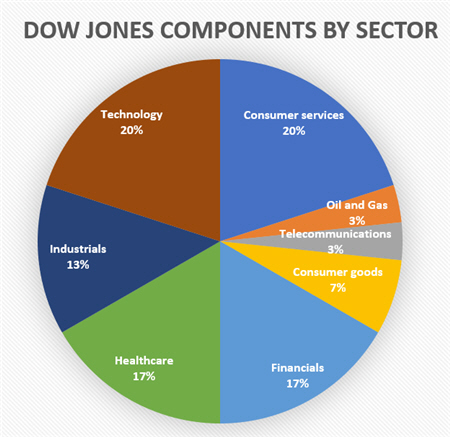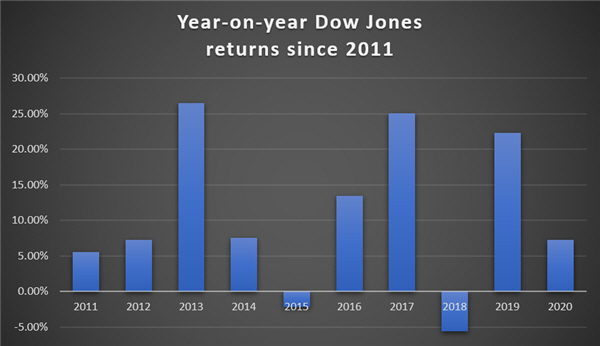Test NanoTrader Full I Test Tradingview I Test the mobile platforms All for CFD-Forex & Futures
You are here
Dow Jones trading guide: constituents, market hours and how to trade

The Dow Jones is the definitive American index of blue chip stocks. Discover more about what moves the Dow Jones price, the nature of its constituents, and how you can go about trading it.The following topics are covered in this article:
- What is the Dow Jones?
- About Dow Jones constituents
- How is the Dow Jones calculated?
- What does the Dow Jones price mean?
- What affects the Dow Jones price?
- Average returns of the Dow Jones
- Dow Jones market hours
- How to trade the Dow Jones
- How do I short the Dow Jones Industrial Average?
- Dow Jones companies ranked by weighted share price
Trading the Dow Jones 30
What is the Dow Jones index?
The Dow Jones Index, or the Dow Jones Industrial Average, is a stock index that tracks the performance of 30 of the largest US companies. As such, it is a key gauge of financial market strength and one of the world’s most quoted equity benchmarks.
Created in 1896 with a published average of 40.94, the Dow Jones is among the oldest index in the world. It is a price-weighted index, which means its value is calculated differently from say the German Dax or the FTSE 100, which are weighted by market cap. In the case of the Dow, the value of the index is derived from the per-share price of its constituents.
Such constituents are chosen for inclusion in the Dow Jones by S&P Dow Jones Indices. While some assume that the 30 companies are the largest in the US, it’s important to remember that the price-weighted nature means that this isn’t the case.
About Dow Jones constituents
The largest constituents of the index by weighting feature healthcare giant UnitedHealth Group, investment bank Goldman Sachs and home improvement retailer Home Depot. Also among the highest profile businesses featured in the index are electronics stalwart Apple, aerospace leader Boeing and fast food mainstay McDonald’s. A more recent addition to the index is software company Salesforce, which was listed in August 2020.
Here’s how the Dow Jones sector composition looked as of May 14 2021.

How is the Dow Jones calculated?
The Dow Jones is calculated as a price-weighted index, as mentioned above. The individual prices of its constituent stocks are added together and then divided by the ‘Dow divisor’, a figure designed to account for the potentially anomalous impact of stock splits or modifications to the index.
The resulting list of stocks features the companies with the highest share prices at the top, as opposed to indices where the leading stocks are determined by market cap.
What does the Dow Jones price mean?
The price of the Dow Jones indicates whether the share prices of the companies on the index are rising or falling. If the price of the Dow Jones is increasing, it means that a specific company or group of companies are experiencing gains, which is reflected in the price of the overall index. Conversely, if the Dow Jones price is falling, it means that companies on the index are experiencing a decline in price.
The Dow Jones ranking is based on a weighted average of share prices. This means companies with a larger weighting will often see their share price fluctuations have a correspondingly outsized impact on the wider index.
What affects the Dow Jones price?
The Dow Jones price is affected by a variety of fundamental and technical drivers linked to the performance of the US economy, as well as international influences. Federal Reserve monetary policy often has a notable impact, as does foreign exchange rates, economic data releases, and even commodity prices.
While such drivers may be expected to move the index in a certain direction, there is no guarantee that the move will play out, so traders should consider how determining factors work together rather than simply isolate any one factor. That said, here are a few of the key things to consider when trading the Dow Jones.
Monetary policy and economic releases
Accommodative monetary policy from the Federal Reserve, which boosts the quantity of money and credit higher and reduces interest rates, tends to assist stocks in rallying, and the Dow Jones is no exception.
Additionally, economic data releases can have a large influence on trading decisions. Inflation is one measure that can hit stock indices as it can erode profit margins across sectors. For example, in May 2021 data showing an accelerating rate of inflation caused the Dow Jones to fall by 681 points.
Individual company performance
As mentioned, companies that are weighted the highest in the index are more capable of moving the index than smaller constituents. For example, UnitedHealth Group is considerably more capable of causing changes in the Dow Jones price than Apple, for instance, despite the latter’s market cap being around six times greater than the former.
Socio-political events
Events such as the Great Recession and the coronavirus pandemic are all capable of hitting market demand in one way or another. For example, the pandemic in 2020 had a particularly outsized impact on key sectors such as aviation and banking, with Boeing and JP Morgan seeing share prices plummet in March 2020.
Average returns of the Dow Jones
Over the last ten years, the Dow Jones has produced an average annual return of 10.7%. The Dow Jones’s average returns are essentially what managed funds will have earned in profit for investors over the course of a year.
You can see the yearly returns from 2011-2020 below. Remember, past returns are no guarantee of future performance.

Dow Jones market hours
The Dow Jones matches regular trading hours for the broader US stock market, 9:30 am to 4 pm Eastern time on weekdays. However there is also pre-market trading which can extend as early as 4 am and go through the market open at 9:30 am. Additionally, after-hours sessions may span from 4 to 8 pm.
Dow Jones CFDs
Contracts for difference (CFDs) are derivatives that take their price from the underlying market, in this case the Dow Jones. As you’ll never be taking ownership of an asset, you can speculate on whether the index is going to rise or fall in value. Recommended CFD-Forex broker: www.whselfinvest.com
Dow Jones futures
Futures contracts are agreements to exchange an asset at a set price on a set expiry date. Unlike most futures, Dow Jones contracts don’t have an underlying physical asset to exchange, as an index is nothing more than a number representing a group of stocks. Recommended futures broker: www.whselfinvest.com
Dow Jones companies ranked by weighted share price
Here are the Dow Jones companies ranked by weighted share price, correct as of May 14 2021. Source: Dow Jones.
Top 15

Other 15

People also read
- What you need to know about the change to the DAX 40 index
- Do experienced investors invest in cryptocurrencies?



